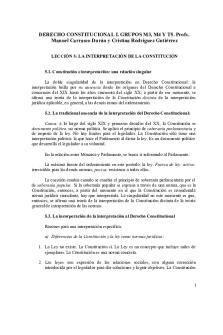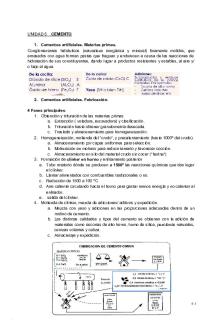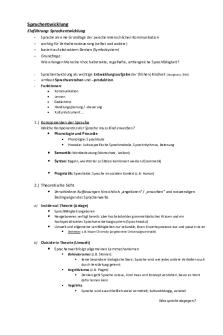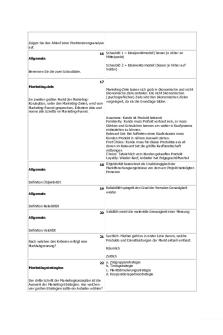5 6109488934432015 427 PDF

| Title | 5 6109488934432015 427 |
|---|---|
| Author | Johns Shibu |
| Course | cost and management accountant |
| Institution | Institute of Cost Accountants of India |
| Pages | 60 |
| File Size | 2.1 MB |
| File Type | |
| Total Downloads | 50 |
| Total Views | 127 |
Summary
Operations Management And Strategic Management Summary...
Description
OPERATIONS MANAGEMENT AND STRATEGIC MANAGEMENT
P a g e |1
Contents 1. Operation Management – Introduction .................................................................................................................... 2 2. Operations planning .................................................................................................................................................. 4 3. Designing of Operational Systems and Controls ......................................................................................................12 4. Production Planning and Control............................................................................................................................. 15 5. Productivity Management and Quality Control: ...................................................................................................... 22 6. Project Management: .............................................................................................................................................. 25 7. Economics of Maintenance and Spares Management: ........................................................................................... 28 8. Strategic Management Introduction ....................................................................................................................... 30 9. Strategic Analysis and Strategic Planning: ............................................................................................................... 36 10. Formulation and Implementation of Strategy ....................................................................................................... 43 Formula compilation....................................................................................................................................................50 Sincere thanks to Shahul for helping in compiling the theory
For Classes at SIRC of ICMAI Classes by PB Srivathsan | 9940041768
OPERATIONS MANAGEMENT AND STRATEGIC MANAGEMENT
P a g e |2
1. Operation Management – Introduction Operat Operating ing Syst System em em: Configuration (collection) of resources combined for the provision of goods and services. Example: Transport System, Hospital, nervous system in humans Operat Operations ions M Managem anagem anagement: ent: Operations are that part of the organisation, which is responsible for producing goods and services. Operations management is nothing but managing those operations. Two ob objectives jectives of Oper Operations ations M Managem anagem anagement: ent: 1. Customer service: • Every business runs only because of its customers, hence satisfying their needs and wants is one of the key objectives of operations management. • This key objective can be satisfied by providing ‘The right product’ at ‘The right place’, at ‘The right time’. 1. Resource utilization: • To deliver the product correctly and satisfy the customers, resources in the organisation are to be used. • These resources must be used in the most effective manner, to reduce losses and thus reducing the possibility of operational failure. Scop Scope e of Opera Operations tions M Managem anagem anagement: ent: Basically, the job of an operations manager is to make sure that operations (conversion of raw materials into finished goods or conversion of human resources into usable services) are carried out smoothly. To do this he has to focus on the following areas: 1. Location of facilities. 2. Plant layouts and Material Handling. 3. Product Design. 4. Process Design. 5. Production and Planning Control. 6. Quality Control. 7. Materials Management. 8. Maintenance Management. Prod Production uction an and d Operat Operations ions Ma Manageme nageme nagement: nt: There are two key differences between production and operations management: 1. Production management is used to denote a system where tangible products are produced, whereas operations management is used to denote a system where inputs are converted into usable services. Example of products would be mobile phones, computers etc, Example of services would be PUBG servers giving online playing service, Accounting back offices etc. 2. Second distinction is with the historical growth of the subject, operations management is the widely used term in the present days, whereas production management is fading nowadays. Moder Modern n Oper Operations: ations: There is a vast difference between operations, at present and five decades back. Today’s modern operation can be characterised by 4 important features: 1. Manufacturing as a competitive advantage: Five decades back, due to less competition, manufacturers need not break any sweat to sell their products. But, at present time due to increased competition, the manufacturers are forced to deploy modern techniques to survive and succeed. There are various techniques used by the companies to gain competitive advantage TQM, Time-Based Competition, Business Process Re-engineering (BPRE), Just-in-Time (JIT), Focused Factory, Flexible Manufacturing Systems (FMS), Computer Integrated Manufacturing (CIM), and The Virtual Corporation are some of them.
For Classes at SIRC of ICMAI Classes by PB Srivathsan | 9940041768
OPERATIONS MANAGEMENT AND STRATEGIC MANAGEMENT
P a g e |3
2. Service orientation: Due to heavy competition, mere production is no more sufficient to satisfy the customers, hence manufacturers have to keep in mind the peculiar service components. The entire manufacturing needs to be geared to serve (i) intangible and perishable nature of the services, (ii) constant interaction with clients or customers, (iii) small volumes of production to serve local markets, and (iv) need to locate facilities to serve local markets. There is increased presence of professionals on the production, instead of technicians and engineers. 3. Disappearance of smokestacks: Due to increased environmental awareness and protective labour legislation, there has been a huge transformation in the production system. Factories have become environmental and employee friendly. Recent trends iin n Prod Production/O uction/O uction/Operation peration perationss Man Management agement agement:: Please refer to study material for this topic
For Classes at SIRC of ICMAI Classes by PB Srivathsan | 9940041768
OPERATIONS MANAGEMENT AND STRATEGIC MANAGEMENT
P a g e |4
2. Operations planning Forec Forecasting: asting: Forecasting means peeping into the future. As future is unknown and is anybody’s guess but the business leaders in the past have evolved certain systematic and scientific methods to know the future by scientific analysis based on facts and possible consequence. Thus, this systematic method of probing the future is called forecasting. In this way forecasting of sales refers to an act of making prediction about future sales followed by a detailed analysis of facts related to future situations and forces which may affect the business as a whole Which is the sstarting tarting point? Objective determination is the starting point of forecasting, or in other terms, “what for?” is the first question in forecasting. Examples: Objective might be to Predict or foresee any of the following • Demand, • Sales, • Cost, etc. Forec Forecast ast rang ranges: es: Forecast maybe for a short term, mid-term or a long term Short term: range from a week to two months Mid-term: range from 3 months to a year Long term: any range more than a year What influenc influences es forec forecast? ast? Pro Prospectiv spectiv spective: e: Since forecast is about predicting the future, there are various factors which influences it. What factors to be co considered nsidered to forec forecast? ast? Prosp Prospective: ective: 1) Environmental changes, 2) Changes in the preference of the user, 3) Number of competitive products, 4) Disposable income of the consumer. Steps: Every objective has a process flow or steps to accomplish it: 1) Determine the objective of forecast 2) Select the period over which the forecast will be made 3) Select the method you want to use for making the forecast. 4) Gather information to be used in the forecast. a. Primary b. Secondary 5) Make the forecast Meth Methods: ods: Methods in forecasting are devised by experts in the respective field (marketing, production etc). Each individual might have his own methods based on his experiences: sales and marketing experts have proposed their methods in sales forecasting based on their experience. Methods in sales forecasting: 1) Survey of buyer’s inventions or the user’s expectation method: Since it is going to be the users who are going to use the product, getting their feedback is one of the methods the managers deploy to predict the preference of the customer.
For Classes at SIRC of ICMAI Classes by PB Srivathsan | 9940041768
OPERATIONS MANAGEMENT AND STRATEGIC MANAGEMENT
P a g e |5
2) Collective opinion or sales force composite method: Sometimes managers trust their own experience when it comes to decision making, thus all levels of employees from salesman to senior vice president of marketing discusses together to obtain a solution. 3) Group executive judgement or executive judgement method: Sometimes top executives sit together and plan as to what is best, this method of forecasting might involve top executives of all disciplines like (Sales, marketing finance, production etc) 4) Experts opinion: Sometimes organisations take opinions of the experts outside the organisation, for their decision-making purposes. There are various consulting groups like BCG, McKinney to help organisation in making their decisions, or even for their forecasting needs. 5) Market test method: This method is most frequently used by existing companies to test for new products, free samples given along with the purchase of an established product is the most common technique. Free samples / products on discounts are given and are later surveyed for their acceptance among the customers. 6) Trend projection method: Under this method, past performance of the company is assessed and used to make future predictions. Example: Sales of umbrella would be high on rainy seasons and low during summer. The most common method used for trend projection is least squares or best line fit. Capaci Capacity ty Planni Planning: ng: Capacity planning is nothing but addressing the three questions with regards to capacity namely 1) What kind is needed? 2) How much is needed? 3) When it is needed? Why is capaci capacity ty planni planning ng need needed? ed? Capacity planning is required for the following: 1) Sufficient capacity is required to meet the customers demand in time, 2) Capacity affects the cost efficiency of operations, 3) Capacity affects the scheduling system, 4) Capacity creation requires an investment, 5) Capacity planning is the first step when an organisation decides to produce more or new products. Rang Range: e: Capacity planning could be either for a long term or for a short term. Long term could be of planning for investments in newer facilities or equipment’s Short term capacity planning could be of determination of manpower for the current month etc Effecti Effective ve Capac Capacity: ity: Effective capacity refers to actual or practical capacity, the firm is capable of producing over a period of time. It can be determined through various factors 1) Facilities - design, location, layout and environment. 2) Product - Product design and product-mix. 3) Process - Quantity and quality capabilities. 4) Human factors - Job content, Job design, motivation, compensation, training and experience of labour, learning 5) rates and absenteeism and labour turn over. 6) Operational factors - Scheduling, materials management, quality assurance, maintenance policies, and 7) equipment break-downs. 8) External factors - Product standards, safety regulations, union attitudes, pollution control standards. How tto o measur measure? e? Output based based:: Capacity is measured based on how many units of production can be done in the production plant. This is known as output-based measurement. Example: How many ‘Lays packets’ can be produced in Lays production plant. For Classes at SIRC of ICMAI Classes by PB Srivathsan | 9940041768
OPERATIONS MANAGEMENT AND STRATEGIC MANAGEMENT
P a g e |6
Input based: Capacity can also be measured based on how many inputs the facility can take. Example: How many users can a PUBG Server or Facebook server intake to play or use at the same time. **Capacity Capacity Planni Planning ng Decisi Decisions: ons: Capacity planning involves activities such as: (i) Assessing the capacity of existing facilities. (ii) Forecasting the long-range future capacity needs. (iii) Identifying and analysing sources of capacity for future needs. (iv) Evaluating the alternative sources of capacity based on financial, technological and economic considerations. (v) Selecting a capacity alternative most suited to achieve strategic mission of the firm. **Factors Factors affecting determi determination nation of plant capacity capacity:: (i) Capital investment required, (ii) Changes in product design, process design, market conditions and product life cycles, (iii) Flexibility for capacity additions, (iv) Level of automation desired, (v) Market demand for the product, (vi) Product obsolescence and technology obsolescence and (vii) Type of technology selected Forms of capac capacity ity plann planning: ing: Time Range: Long term and Short term Resources Based: Finite and Infinite Factor Factorss Affecti Affecting ng Capa Capacity city Plan Planning: ning:
Facto Factors rs Labo Labour ur
Pro Productio ductio duction n
Con Controll troll trollable able Amount of labour Shifts of labour working days overtime worked Installed machine capacity Preventive maintenance
Un Uncounta counta countable ble Performance of labour Strike Absenteeism Material shortages Break down
Capaci Capacity ty requi requirement rement rement:: After setting the objective, like how many units to be produced etc, the organisation now has to plan the required capacity to fulfil the necessary requirement. Example: Capacity to supply 1000 tons of output by a given date. Level Capacity Plan: Level capacity plans are those plans where production is at the same level, irrespective of the capacity demanded. That is, if the demand is only 80 units, and 100 units are produced, the balance 20 units are kept as inventory for future sales. Matchi Matching ng cap capacity acity wit with h dema demand nd plan plan:: These are those plans where production matches with the quantity demanded. That is, if the demand is 80, production will also be 80, for that period. In this method there is minimal to no inventory, hence reducing inventory cost. But it also leads to increased ordering cost.
For Classes at SIRC of ICMAI Classes by PB Srivathsan | 9940041768
OPERATIONS MANAGEMENT AND STRATEGIC MANAGEMENT
P a g e |7
Factor Factorss influe influencing ncing Ef Effective fective C Capacity: apacity: 1. 2. 3. 4. 5.
Forecasts of demand Plant and labour efficiency Subcontracting Multiple shifts Management policy
Over and und under er capaci capacity: ty: As future can never be predicted with absolute certainty, there is always a chance of either having capacity more than required (demand) or less than required. This is known as having over capacity or under capacity. Whe When n over ca capacity pacity is favoure favoured: d: An internet server is a very good example for, when an over capacity is of no harm. Since prediction of expected users is very difficult, extra servers could be added, to tackle unexpected rush in server, and keeping the server running. The cost of ‘upgrading’ and maintaining the server is also negligible as once the server and the connections are setup, it’s just a matter of adding more HDD’s to the existing set-up. **Fac **Factors tors favo favouring uring ov over er capa capacity: city: (a) Fixed cost of the capacity is not very high. (b) Subcontracting is not possible because of secrecy of design and/or quality requirement. (c) The time required to add capacity is long. (d) The company cannot afford to miss the delivery and cannot afford to lose the customer. (e) There is an economic capacity size below which it is not economical to operate the plant. Whe When n under capacity is prefer preferred: red: Under capacity is preferred in places like chicken stalls, hotels etc, where the goods sold, are easily perishable and should be sold within a limited timeframe. **Fac **Factors tors favo favouring uring un under der ca capacity: pacity: (a) Shortage of products does not affect the company (i.e., lost sales can be compensated). (b) The technology changes fast, i.e., the rate of obsolescence of plant and equipment are high. (c) The cost of creating the capacity is prohibitively high. Proce Process ss Bottle N Neck: eck: Bottleneck is a term, used to refer to piling up of inventories, or one process slowing down others (in a multi-process environment) it’s like having a weak process which causes other process to wait for it, or limit the other processes from utilising its full capacity. Examples are: Recollect the furniture shop or the pizza restaurant example Facility Locati Location: on: It is one of the most important function to be considered before starting any organisation. Proper availability of labour, raw materials, governmental regulations are the most important factors to be considered during location determination Steps in locatio location n selecti selection: on: Doing business in the world that we live in today is a little more complicated (as various points have to be considered) than it was 20-30 years ago. The most important considerations are: 1) Choosing whether it is domestic or international: Ever since globalization, international trade is rampant, and markets are free and open for anyone to trade. But it doesn’t mean trading in every country is same, a) Political stability For Classes at SIRC of ICMAI Classes by PB Srivathsan | 9940041768
OPERATIONS MANAGEMENT AND STRATEGIC MANAGEMENT
P a g e |8
b) Governmental policy c) Peoples sentiment, culture etc. Are very much different in each country, hence a careful study of which country would be best suited for our product has to be made. 2) selecting a particular region/state in the chosen country: Once the country is decided, then it comes to narrowing to which is the most suitable region. Again, various factors have to be considered in choosing the region lik e: a) Raw material availability: Raw materials enables the business to run, if it is available in the region that we chose, it could reduce the cost of transporting, b) Market nearness: Businesses are run to sell the product which they produce in the market, hence again if the region selected is the region where the market is located, it could eliminate the cost of transporting the finished product c) Availability of power: Power is crucial for converting raw materials to finished goods, hence it is one of the important considerations that is made when choosing a location. d) Transport facilities: It is not always the case that all the products produced will be sold in the market where the facility is located, there will be mostly a case where it has to be sent to other markets, hence there should be easiness in transporting those products to outside market. e) Governmental policy: Governmental influences the business in various ways, and in most of the countries where there is a federal system, where to an extent, each of the states are permitted to have their own law (Like India, USA, etc.) considering govt. policies before placing our facility becomes critical. In India lot of tax benefits are being given to invest in low-developed states, SEZ’s etc. f) Climate: While climate may not be important in every form of business, it is very much important for some of the businesses, Example: any business related to agriculture, like growing crops, growing fruits, etc. 3) Choosing...
Similar Free PDFs

5 6109488934432015 427
- 60 Pages

Patchi 427 - projct
- 7 Pages

LER 427 Exam 1 Sample Questions
- 3 Pages

5
- 4 Pages

5
- 1 Pages

Test 5 - Test 5
- 6 Pages

TEMA 5 - Apuntes 5
- 2 Pages

5 Heladas - Apuntes 5
- 17 Pages

Session 5 - ELS 5
- 2 Pages

TEMA 5 - Apuntes 5
- 3 Pages

Leccion 5 - Apuntes 5
- 10 Pages

5. Cementos - Apuntes 5
- 10 Pages

TEMA 5 - Apuntes 5
- 6 Pages

TEMA 5 - Apuntes 5
- 2 Pages
Popular Institutions
- Tinajero National High School - Annex
- Politeknik Caltex Riau
- Yokohama City University
- SGT University
- University of Al-Qadisiyah
- Divine Word College of Vigan
- Techniek College Rotterdam
- Universidade de Santiago
- Universiti Teknologi MARA Cawangan Johor Kampus Pasir Gudang
- Poltekkes Kemenkes Yogyakarta
- Baguio City National High School
- Colegio san marcos
- preparatoria uno
- Centro de Bachillerato Tecnológico Industrial y de Servicios No. 107
- Dalian Maritime University
- Quang Trung Secondary School
- Colegio Tecnológico en Informática
- Corporación Regional de Educación Superior
- Grupo CEDVA
- Dar Al Uloom University
- Centro de Estudios Preuniversitarios de la Universidad Nacional de Ingeniería
- 上智大学
- Aakash International School, Nuna Majara
- San Felipe Neri Catholic School
- Kang Chiao International School - New Taipei City
- Misamis Occidental National High School
- Institución Educativa Escuela Normal Juan Ladrilleros
- Kolehiyo ng Pantukan
- Batanes State College
- Instituto Continental
- Sekolah Menengah Kejuruan Kesehatan Kaltara (Tarakan)
- Colegio de La Inmaculada Concepcion - Cebu

